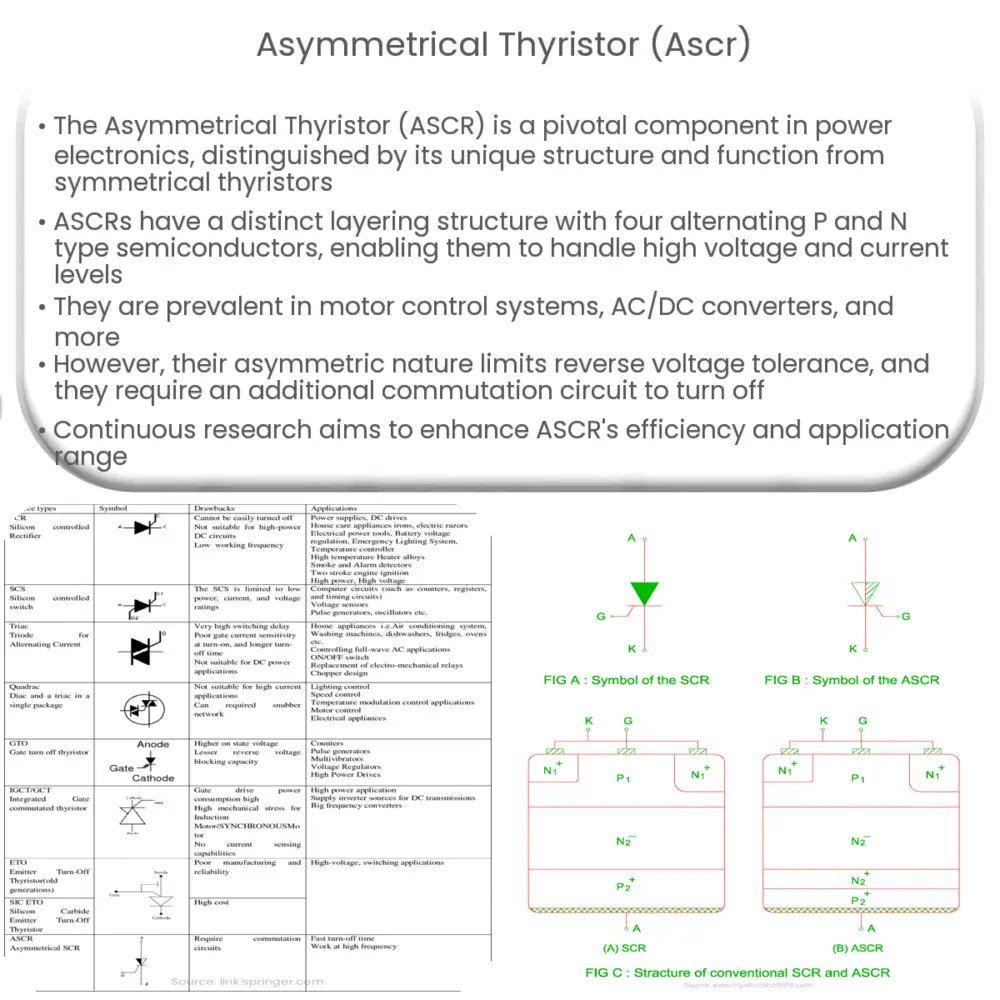Explore the structure, functioning, applications, advantages, and limitations of Asymmetrical Thyristors (ASCR) in power electronics.

Introduction to Asymmetrical Thyristor (ASCR)
The Asymmetrical Thyristor, often abbreviated as ASCR, is an essential component in the field of power electronics. The ASCR is a type of thyristor that differs from the symmetrical thyristor due to the dissimilarity in its structure and functionality.
Structure of Asymmetrical Thyristor
The asymmetrical thyristor is a three-layer, three-junction, four-layer semiconductor device. It consists of three PN junctions and four alternating layers of P and N type semiconductors. Unlike symmetrical thyristors, which have identical P-N-P-N structures, ASCRs feature a different layering structure, which gives them their asymmetrical characteristic.
-
The first layer (closest to the anode) is P-type, and it carries the majority of the anode current.
-
The second layer is N-type, and it’s responsible for the majority of the cathode current.
-
The third layer is again P-type but has a considerably lower doping concentration compared to the first layer.
-
The fourth layer (closest to the cathode) is N-type, and it serves as the cathode contact layer.
Functioning of Asymmetrical Thyristor
The operational principle of the ASCR is similar to that of the standard thyristor, with some subtle differences due to its unique structure. The device operates in three modes: forward blocking mode, forward conducting mode, and reverse blocking mode.
-
In the forward blocking mode, the anode voltage is positive with respect to the cathode, and no gate current is supplied. The thyristor remains in its off state, despite the positive voltage across it.
-
In the forward conducting mode, the thyristor is triggered into the on state by a positive gate current. Once the device is on, it stays on, even if the gate current is removed, until the anode current drops below a certain hold current.
-
The reverse blocking mode occurs when the cathode voltage is positive with respect to the anode. In this mode, the thyristor blocks the current flow, just as it does in the forward blocking mode.
Applications of Asymmetrical Thyristor
ASCRs are extensively used in power electronics, primarily because they allow for controlled rectification and cycloconversion. Their structure and operation make them suitable for applications that require high voltage and current capabilities. They are typically found in:
-
Motor control systems
-
AC/DC converters
-
Heat control systems
-
Light dimmers
Advantages and Limitations of Asymmetrical Thyristors
ASCRs come with a set of advantages and limitations which define their suitability for various applications.
-
The primary advantage of ASCRs lies in their ability to handle high voltage and current levels, making them a powerful asset in power electronics.
-
Their controllable switching makes them ideal for applications requiring controlled power delivery.
-
They are also robust and durable, with a long operational life, further increasing their practical value.
However, there are some limitations to consider.
-
The asymmetric structure of these thyristors means they can’t withstand high reverse voltage. Therefore, they are not suitable for applications requiring full-wave rectification.
-
ASCRs also require an additional commutation circuit to turn them off, as removing the gate current does not immediately turn off the device.
-
Lastly, these thyristors require a certain amount of hold current to maintain conduction, limiting their efficiency in low current scenarios.
Developments in Asymmetrical Thyristors
Despite their limitations, ongoing research and development in the field of power electronics aim to improve the performance and versatility of ASCRs. Some of the potential advancements include enhancing the device’s reverse voltage capabilities and reducing the hold current requirement. These advancements would not only increase the efficiency of these devices but also broaden their application range.
Conclusion
The Asymmetrical Thyristor (ASCR) is a fundamental device in power electronics, with its unique structure and functionalities setting it apart from symmetrical thyristors. Its capability to control high power and its robustness make it a vital component in various applications, such as motor control systems and AC/DC converters.
Despite some limitations, like the inability to handle high reverse voltage and the requirement for an additional commutation circuit, the ASCR remains an essential device. With ongoing research and development in this field, it is anticipated that the performance and utility of ASCRs will continue to increase, making them even more integral to the future of power electronics.

